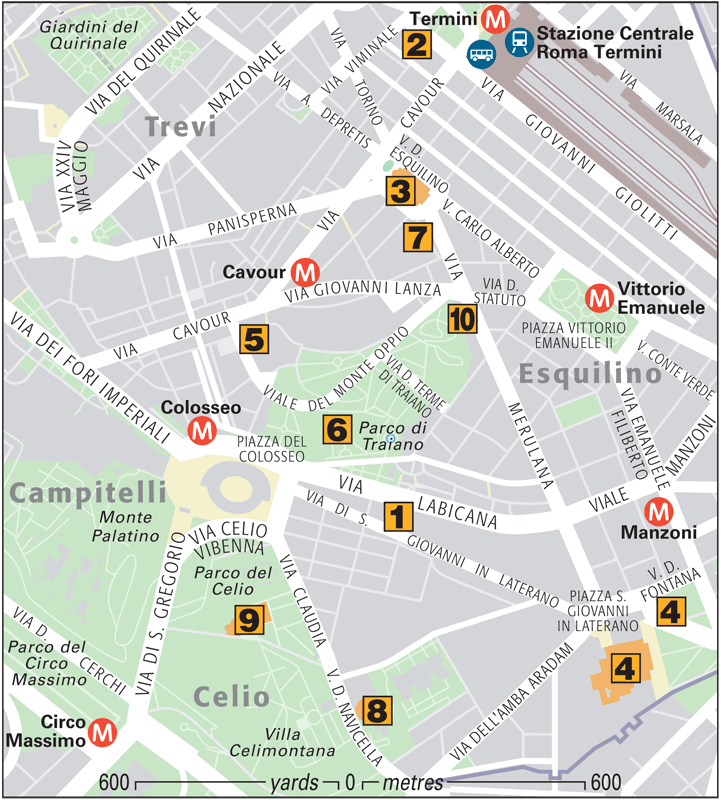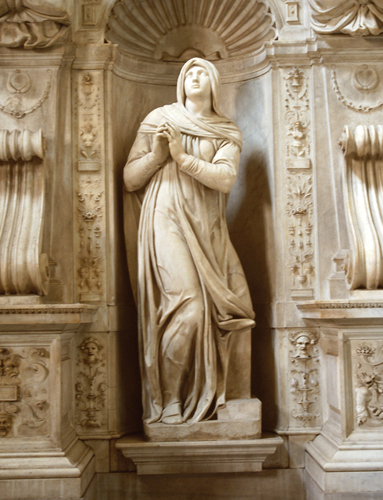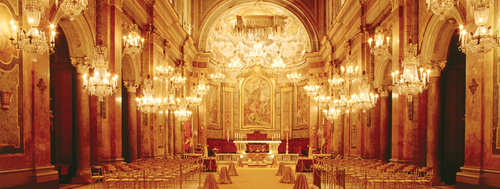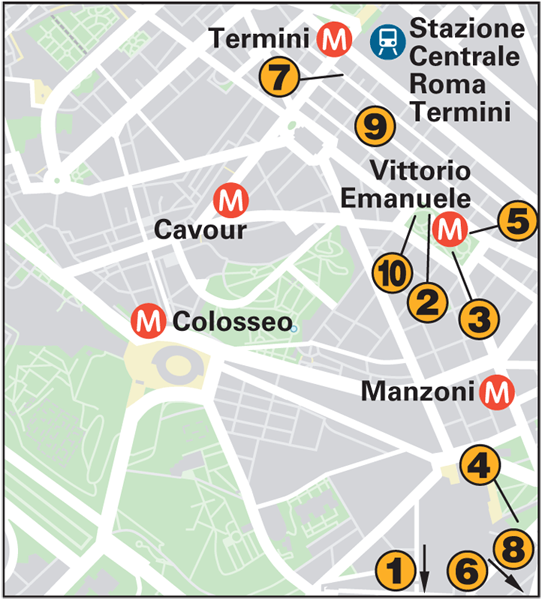The Esquiline and Lateran
In ancient times the largest of Rome’s seven hills was almost entirely residential, consisting mostly of upper-class villas. The western slope of the quarter, just behind the Imperial Fora was considered rather unhealthy as it was densely populated – the massive wall at the back of the Fora was intended to keep the squalid slum out. However, in the 4th century, this zone became central to the development of Christianity. In setting up the religion as the official faith, Constantine did not dare step on too many pagan toes, so he established Christian centres outside of town, on the sites of holy tombs. The main one was what is now San Giovanni in Laterano (Saint John in Lateran). Other churches quickly followed, culminating in the striking Santa Maria Maggiore, built in the 5th century. The district remains steeped in history and religious mystique.
Establishment of the ChurchThis area played a central role in early Christianity. Although Constantine himself was not a convinced convert, his mother, St Helena, was indefatigable in her promotion of the new religion. She convinced her son to found the official seat of the Bishop of Rome on the site of the ancient Laterani family villa, which his wife Fausta had inherited. |

|
|
Sights
San Clemente
Architectural layers of this church unravel Rome’s history, from the 2nd century BC to the 15th century AD (see San Clemente).
Catacomb, San Clemente
Palazzo Massimo alle Terme
Housing an extraordinary collection of ancient frescoes, mosaics and sculpture, this branch of the Museo Nazionale Romano is perhaps the most inspiring. The building itself was erected by the Massimo family at the end of the 19th century and later served as a Jesuit college (see Museo Nazionale Romano).
Santa Maria Maggiore
This church is a unique blend of architectural styles. The nave and its mosaics are original 5th-century; the Cosmatesque work, the apse mosaics and the Romanesque bell tower are medieval; the coffered ceiling (of New-World gold) is Renaissance; and the twin domes and front and back façades are Baroque. Pope Sixtus V erected the Egyptian obelisk in 1587 as part of his overall town-planning, to provide landmarks for pilgrims. The column in front was taken from the Basilica of Maxentius and Constantine in 1615 (see Santa Maria Maggiore).
Piazza di S Maria Maggiore
Open 7am–7pm daily
Free
Façade, Santa Maria Maggiore
San Giovanni in Laterano and Scala Santa
Besides its grandiose Baroque bulk, visible from all over Rome, this former papal complex boasts the world’s first baptistry, its octagonal shape the model for all those to come. A building on the piazza houses the Scala Santa, claimed to be the staircase from Pontius Pilate’s house that Jesus ascended to face his trial – the devout climb the 28 steps on their knees. Tradition says that the stairs were brought from Jerusalem by St Helena, mother of Emperor Constantine (see San Giovanni in Laterano).
Piazza di S Giovanni in Laterano
Open 7am–7pm daily (cloisters 7am–9pm; baptistry 7am–12:30pm, 3–6:30pm)
Adm to cloisters
Statue, San Giovanni in Laterano
San Pietro in Vincoli
Michelangelo’s Moses is the unmissable experience here. Weirdly horned and glaring, the righteously indignant patriarch is about to smash the tablets down in outrage at his people’s idolatry. This powerful sculpture was just one of 40 the artist planned, but never finished, for the tomb of Pope Julius II (see Michelangelo’s Moses). It has recently been restored. The original shrine was built in the 4th century to house the chains supposedly used to bind St Peter in prison. It has been rebuilt since, first in the 8th century and again in the 15th century.
Piazza di S Pietro in Vincoli 4A
Open 8am– 12:30pm, 3:30–7pm daily (until 6pm Oct–May)
Free
DA
Statuary, San Pietro in Vincoli
Nero’s Golden House
Subsequent emperors were so embarrassed by Nero’s gargantuan profligacy that they went to great lengths to undo as much of it as they could. One way was to give some of the land Nero took for himself back to the use of the Roman people. The Flavians drained his lake and built the Colosseum, to provide the citizenry with a suitable place for their gladiatorial spectacles. Then Trajan built Rome’s first great bath complex by cutting through Nero’s original house and building right over it (see Nero’s Golden House).
Viale della Domus Aurea
Ticket reservation 06 3996 7700
Adm
DA

Santa Prassede
Built in the 9th century over a 2nd-century oratory, the original design is still discernible despite restorations. In the central nave, a stone slab covers the well where St Prassede is said to have buried 2,000 martyrs. Byzantine artists decorated the apse with mosaics depicting saints, lambs, palm trees and poppies. The walls and vaults of the Chapel of St Zeno also have mosaics from the same period, and there is a fragment of the column Christ was bound to when he was flogged.
Via S Prassede 9A
Open 7:30am–noon and 4–6:30pm daily (from 8am in winter)
Free
DA
Mosaic, Santa Prassede
Santo Stefano Rotondo
The unusual shape of this early church (468–83) may mean it was built over Nero’s round Macellum Magnum (meat market). Or perhaps its form was inspired by Jerusalem’s Church of the Holy Sepulchre. Whatever the case, recent digs have found a Mithraeum underneath. The structure is a peaceful, delightful sanctuary, situated far from urban uproar, although 16th-century frescoes by Niccolò Pomarancio depict martyrdoms in sadistic fashion.
Via di S Stefano Rotondo 7
Open 9:30am–12:30pm, 3–6pm Tue–Sun (to 5pm in winter)
Free

Santi Giovanni e Paolo
The eponymous saints were 4th-century martyrs and their home is still seen under the 5th-century structure. They were beheaded here in 361 on orders from Emperor Julian. Except for the Late Baroque interior, much of the church is pure medieval. The base of the bell tower is that of the 1st-century Temple of Claudius that once stood here.
Piazza SS Giovanni e Paolo 13
Open 8:30am–noon, 3:30–6pm daily
Free
Nave, Santi Giovanni e Paolo
Oriental Art Museum
A fine, though small collection of Middle and Far Eastern art, ranging from prehistoric Persian ceramics to 18th-century Tibetan paintings. The most fascinating works are the Ghandharan. These 3rd-century BC to 10th-century AD Indian Buddhist works display both Asian and Greek influences, due to the conquest of the area that is now Pakistan by Alexander the Great.
Via Merulana 248
Open 9am–2pm Tue, Wed, Fri; 9am–7:30pm Thu, Sat, Sun
Adm
DA
Exploring Rome’s Early Churches
Morning
Start with San Clemente , with its fascinating layers. At the lowest level use a torch (flashlight) to appreciate the beautiful fresco of the head of a bearded man.
Walk one block over to the Via dei Santi Quattro Coronati to glimpse the produce market; turn left and walk up the hill to Santi Quattro Coronati, a rich and little visited 4th-century church with remarkable frescoes in the chapel (1246). Continue on until you reach San Giovanni in Laterano . The cloisters with gorgeously twisted columns and mosaic inlays will make your visit truly memorable.
For an equally memorable lunch, head to Cannavota .
Afternoon
After lunch, it’s time for another of the great basilicas, Santa Maria Maggiore . Check out the ancient column in front and inside use binoculars to examine the 5th-century mosaics lining the upper reaches of the nave. Finally, cut over to Santa Prassede, where you can take in some of Rome’s most radiant Byzantine mosaics and a powerful painting of the Flagellation in the sacristy.
For sustenance after your spiritual journey, continue down the hill, past Santa Maria Maggiore’s grand staircase and enjoy a drink at L’Angolo di Napoli , or stay for a dinner of Neapolitan-style pizza.
Clothing and Discount Shops

Via Sannio Market
The market is a good bet for new leather jackets at great savings. Otherwise there is a lot of quite junky fakes, good-condition second-hand clothing, and other miscellaneous items (see Via Sannio).
Via Sannio Market
Via Mamiani Market
Exotic foodstuffs, spices, flowers, clothing, luggage – you can find all that and more around this huge market square. Under the porticoes there are even more stalls to check out (see Via Mamiani).
Oviesse
Fairly well-made clothing at bargain prices, plus a large selection of cosmetics and toiletries. This is the largest of several branches of Oviesse in Rome.
Piazza Vittorio Emanuele 108–10
Coin
A fashionable department store, with reasonable prices. It’s mostly clothing, shoes and accessories, but they also carry kitchenware and more general furnishings.
Piazza Appio 7
Barrita Boutique
The lovely, hand-made leather shoes are good value for money. Stock includes boots, shoes and leather bags. A boot-stretching service is also available.
Via Appia Nuova 41
UPIM
A mid- to low-range department store that carries clothing, toiletries and practical items for the home.
Via Gioberti 74
Leam
An extremely trendy clothing emporium with a factory outlet on the top floor selling Prada and D&G.
Via Appia Nuova 26
Exotic Foods
One of the few places in the city where you can find Chinese, Thai and Indian spices and cooking pastes.
Via Napoleone III 95
International Trade Corp
One of many Chinese shops in Rome’s Chinatown. This one specializes in women’s wear.
Piazza Vittorio Emanuele 61/A
Places to Eat

Agata e Romeo
The eponymous couple divide the labour expertly, she as chef and he as maître d’. Try the menu degustazione for a sampling of each day’s masterworks. Reservations a must (see Agata e Romeo).
Via Carlo Alberto 45
06 446 6115
Closed Sat–Sun, 2 weeks Jan & Aug
DA
Baia Chia
Cuisine from Sardinia, which adds up to lots of fish and lots of flavour.
Via Machiavelli 5
06 7045 3452
Closed Sun
DA
Cannavota
A traditional neighbourhood restaurant. Try risotto alla pescatore (seafood risotto).
Piazza S Giovanni in Laterano 20
06 7720 5007
Closed Wed, Aug
DA
Trattoria Monti
This friendly, intimate restaurant serves creative dishes from the Marche region. The tagliatelle con ragù is excellent, and the house Verdicchio wine is above average. Booking in advance is advised.
Via di San Vito 13A
06 446 6573
Closed Mon, Sun D, Aug
F.I.S.H.
Seafood and fusion cuisine served by a bilingual staff.
Via dei Serpent 16
06 478 24 962
Closed Aug, Mon L
Little India
Rome’s best value Indian restaurant, is set in two attractive medieval rooms. Tandoori cooking is a speciality.
Via Principe Amedeo 303–05
06 446 4980
Monti D.O.C.
This cosy wine bar has a full menu of hearty Tuscan soups, cous cous, tuna steaks and, for dessert, delicious carrot cake.
Via G Lanza 93
06 487 2696
Enoteca Cavour 313
A clubby old wine bar. Bottles from around the world to choose from, as well as a decent menu of salads, pastas, sandwiches and more.
Via Cavour 313
06 678 5496
Closed Jul–Sep: Sun
L’Angolo di Napoli
Head here for lunch in this light and airy establishment with cafeteria-style service. Great hot or cold buffet selections.
Via Agostino Depretis 77A
06 474 6866
Closed Sun L
Il Guru
Elegant Indian restaurant, a cut above the rest. The food is superbly prepared in north-Indian style.
Via Cimarra 4/6
06 474 4110
Closed L
|

